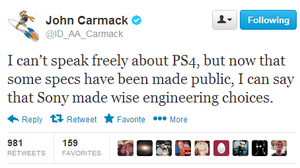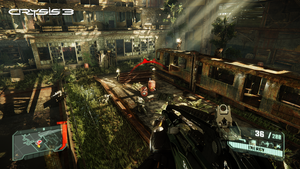Sony's PlayStation 4 launch last Wednesday was monumental, and not just because it may very well be the first console announcement in history where the company failed to actually show the console itself.
While the rest of the world was bemoaning the mythical, missing hardware, Sony also announced some basic high-level hardware specifications for the impending machine. Hidden within the technical jargon was a secret: This so-called console is in fact a full-blown x86 PC at its multicored core. More interestingly, the specs indicate that unlike its predecessor—which was an absolute beast when it launched seven years back—the PlayStation 4 will likely lag behind cutting-edge gaming PCs from the very first day it hits the streets.
That's not exactly a surprise. "If you predict how hardware evolves at the current speed of evolution, and then take consumer pricing evolution, already two years ago you could see [that] whatever [console] launches in 2013 or 2014 or 2015 will never beat a PC again," Crytek head Cevat Yerli recently told Eurogamer.
Sony just proved Yerli correct. Should gamers on either side of the console/PC divide be worried?
The PlayStation 4 by the numbers
Before we dive into portents, let's talk about the PlayStation 4's core technical specifications and how they stack up against desktop gaming rigs. (Fear not—I'll try to keep the jargon to a minimum.)
A "semi-custom" AMD accelerated processing unit (APU) lies at the heart of the PlayStation 4. It's made up of eight CPU cores based on the company's upcoming "Jaguar" architecture. Those Jaguar cores are joined by a next-generation Radeon GPU featuring 18 compute units capable of pumping out 1.84 teraflops of performance power.
As with every other AMD APU, both the CPU cores and the GPU are situated on the same physical die, and the two will have a whopping 8GB of blazing-fast GDDR5 memory to share between them. (Cue Keanu Reeves: Whoa.) Some other specs were announced, but the central APU is really the focus here.
Most of the intricate details about the PlayStation 4's custom-designed hardware are still shrouded in secrecy. But by leveraging what we already know about AMD's technology, we can make a reasonable guesstimate about the console's performance compared to modern-day gaming PCs—and it ain't exactly awe-inspiring.
Comparing apples to apples
First, there's the matter of the CPU cores. Without getting into technicalities, AMD's Jaguar architecture is the impending successor to the "Bobcat" architecture found in the company's current low-power APUs, and it is not especially beefy. While the idea of an octa-core console sounds dreamy on the surface, the illusion is shattered when you realize that on the PC side of things, Jaguar APUs will be modest processors targeted at tablets, high-end netbooks (ha!), and entry-level laptops.
In other words, the PlayStation 4's CPU performance isn't likely to rock your socks compared to a PC sporting an AMD Piledriver- or Bulldozer-based processor. It might not even trump a lowly Intel Core i3 processor, especially if Eurogamer's early PlayStation 4 leaks continue to prove accurate and those eight cores are clocked at 1.6GHz.
Then there's the GPU. The specs don't line up with any of AMD's Radeon HD 7000-series graphics cards, and we can't be sure just how custom the semi-custom GPU actually is. Nonetheless, 1.84 teraflops of performance puts the GPU just ahead of the Radeon HD 7850 and well under the Radeon 7870. That also holds true if you assume the PlayStation 4 GPU's 18 compute units sport a build similar to the GCN architecture used to build AMD's Radeon HD 7000-series graphics cards.
The Radeon HD 7850 is nothing to sneeze at. Indeed, if you're looking for a midrange video card, it's a stellar option. But it's still just a midrange card, not a graphical trail blazer—and yet it will form the backbone of the PlayStation 4's gaming chops for years to come.
Overall, if you compare its hardware to what's available in today's PC landscape, the PlayStation 4 is basically powered by a low-end CPU and a midrange GPU. It even packs a mechanical hard drive in an age when many PC gamers have moved on to lightning-quick solid-state drives.
Comparing apples to hula hoops
But wait! I'm not slamming the PlayStation 4. A gaming PC is not a gaming console. Unlike gaming PCs, which can be overclocked and water cooled and often cost north of $1000, consoles need to balance performance, cost, and thermals in order to appeal to the mainstream masses while simultaneously staying small and quiet enough for living room use. These constraints place inherent limits on what these next-gen consoles can accomplish.
"Given consumer pricing, and given the cost of production of a gamer PC and the amount of watts of power it needs—which is like a fridge—it's impossible [for next-gen consoles to match the power of gaming PCs]," Crytek's Yerli explained in his Eurogamer interview.
All that said, Sony's design decisions make a lot of sense. (Just ask Doom creator and programming prodigy John Carmack.) Assuming AMD's Jaguar cores follow the lead of their Bobcat predecessors, they'll sip power and run cool and quiet.
Sure, an entry-level mobile CPU may not match the raw power of a decent desktop processor, but the PlayStation 4's power will still blow the pants off the PlayStation 3 and Xbox 360 in terms of sheer computing chops—and the GPU has always been the more important component for consoles in any case.
Simply focusing on nuts and bolts, however, ignores the biggest trick the PlayStation 4 has up its sleeve.
"Hardware-only, the PS4’s 2TFLOP capabilities put them on the same bar as AMD’s 7870 when you factor in GPU and CPU," Patrick Moorhead, principal analyst at Moor Insights and Strategy, told us via email. Important note: Moorhead was a longtime VP of Strategy at AMD prior to founding his firm.
"This is only one view, though—the other being software," Moorhead says. "Sony’s development kit and games operate closer to the actual metal of the hardware, meaning they can get it to do more for games than a traditional PC. The PS3 has seven-year-old graphics technology in it, yet it can deliver some very good graphical experiences. Imagine what the PS4 will be able to do with current high-end technology."
Better yet, don't imagine. The video below shows a live demo of the PlayStation 4 titleKillzone: Shadow Fall being played on "Late Night with Jimmy Fallon." (Jump ahead two minutes to cut straight to the gaming action.) Uncanny valley, here we come!
What does it all mean?
So what do the PlayStation 4's computer-esque specs portend for the games industry? By adopting the oh-so-familiar x86 CPU architecture used in PCs, Sony made it a lot easier for developers to build games that work on both computers and consoles with minimal fuss—especially if the Xbox 720 also utilizes a similar AMD APU with 8 Jaguar cores, as has been uttered in fairly credible rumors.
Even better, PC gamers should hopefully see the number of shoddy console ports drop precipitously once the next-gen consoles are here, because console developers will already pretty much be writing their games for PC hardware. The transition may also pay dividends for console gamers, since tapping into the familiar x86 architecture could mean console developers will be able to put the pedal to Moorhead's proverbial metal early in the PlayStation 4's lifecycle.
The PlayStation 4 is also a major win for AMD, and one that will be amplified if the next-gen Xbox indeed uses an AMD APU of its own. Not only does the PlayStation 4 ensure a steady revenue stream for years to come, but it also ensures that all games developed with an eye toward console conversion will be optimized to work on AMD's GPUs—a huge advantage for the (somewhat struggling) hardware giant. The appearance of APUs in mainstream consoles also advances AMD's "heterogeneous system architecture" initiative.
Finally, the PlayStation 4's APU-powered core only cements the fact that gaming is undergoing a convergence. Sorry, pitchfork-wielding fanboys, but the walls you've so vociferously defended on either side of the PC-versus-console debate are being torn down.
PC gaming is breaking away from the desktop, consoles are streaming games to smartphones and being controlled by Windows apps, the PlayStation 4 is nothing more than a computer in a console's clothing, and you can tweet from absolutely any gaming device you can get your grubby hands on. (If the ability to send 140-character messages from everywhere isn't the true meaning of convergence, I don't know what is.)
Yes, the future of gaming is shaping up to be an amorphous any-screen blob, but within that blob, consoles and PCs will continue to remain the commanders of their respective niches. The next generation of consoles will provide an easy-peasy plug-and-play gaming experience, complete with killer extra features and performance that far exceeds what's possible with the current console generation's hardware.
But if you're the type of gamer who lives and breathes on the bleeding edge of polygon-pumping power—one who will accept no less than the highest of details settings and the smoothest of frame rates—it appears as though PC gaming will remain the undisputed heavyweight champion for the foreseeable future. Just remember that great performance comes with a hefty price.

 AMD
AMD
 CRYTEK
CRYTEK
No comments:
Post a Comment